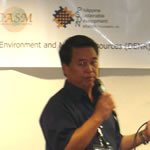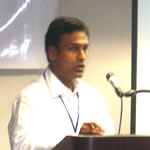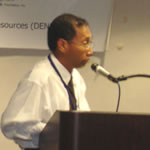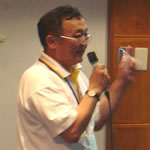 |
 |
|
|
speakers (day 2)
>>>
|
|
|
Godio, Mario
Gold mining was being done in Itogon
before the Chinese traded with the Philippines. After the Spanish war,
the Americans took over having won the war. The Americans
came to discover gold in the hills of Benguet particularly in
Itogon and found native panners along the Antamok River. They soon bought
the land and take claim on the area and in 1902 started formally
the large-scale mining. Soon other mining firms came about.
Though
the big mining firms are operating, the natives and other
immigrants continued to pan and operate as small-scale miners.
They
still thrive up to this day, while all the large-scale mining
firms closed and one is on the verge of folding up. The
area was proclaimed watershed. The small-scale miners are
operating in an underground economy, thus taxes are a no no to
them, which is a problem of the Local Government Unit (LGU).
We
try to protect them but do not get anything from them, except
that they have livelihood which lowers several problems.
The Speaker
Municipal Mayor
Municipality of Itogon
2604 Benguet Province
Philippines
Mobile Phone: 0920-9045066
Fax No: (63)(74)442-3526
I grew up in a mining community in
the municipality of Itogon, Benguet Province. My father was a half Kankanaey and Ibaloi. My
mother is a predominant Kalanguya with traces of Kankanaey and
Ibaloi. My father worked in the lumberyard that supplies the big
mines (Benguet Corporation the Benguet Consolidated, Inc.). I
finish high school in the place where I live in a high school
put up by the mines. Finished my Bachelor�s Degree in Commerce at the
Saint Louis University in Baguio. Worked as a
revenue collector in the municipality from 1975 to 1982, was
elected Barangay Captain (1982-1986) of Loakan where one mining
community is located, Antamok Mines, 1982-1986. Appointed
as councilor in an OIC capacity after the EDSA 1, 1986-1988. Was
elected councilor in 1988 to 1992. Was Executive Assistant to
the mayor for a year in 1993 and appointed as Municipal Planning
and Development Coordinator of the municipality from 1994 to
2001. Elected as mayor in the election of May 2001 and reelected in May 2004.
|
|
|
|
"Free and
Informed Prior Consent"
Sugguiyao, Natividad B.
The Speaker
Provincial officer
National Commission of Indigenous peoples
Tabuk, Kalinga
Philippines
Cell phone :0920 205 2680
E-mail : [email protected]
Ms. Natividad B. Sugguiyao heads the NCIP Provincial office in the
Province of Kalinga. The NCIP is
currently undertaking the Conversion of the Balbalan Certificate
of Ancestral Domain certificate (CADC) to Certificate of
Ancestral Domain Title (CADT). With Kalinga as one of the destinations of mineral ore
explorers, NCIP Kalinga takes the lead role in the FPIC process.
Ms. Sugguiyao is an active environmentalist and aggressively
advocates indigenous people�s rights for the management and
development of their ancestral domain natural resources. With
her initiatives, she has brought Kalinga to the ecotourism map
and as a world-class whitewater destination. Kalinga has a model community based ecotourism outfit
that is owned, developed and managed by the Kalingas themselves.
Ms.Sugguiyao comes from i-Lubo sub tribes of Tanudan, Kalinga .
|
|
|
|
"State Interests in Small-Scale Mining as Reflected
in Mining Legislations
of some Countries in the Asia-Pacific Region"
Bugnosen, Edmund M.
The economic importance of artisanal and
small-scale mining (ASM) well as its attendant adverse
environmental and social effects have encouraged many countries
to adopt legislative measures to address the sector. Policy
approaches, however, is diverse, and the search for an
appropriate and responsive legislation continues. In some countries,
ASM issues are tackled and integrated
within the general mining legislations, while others have
enacted separate and specific ASM laws.
This paper attempts to provide an overview of the
different regulatory measures and practices that were adopted to
date. General comments and observations on some of the key
components of the various legislative measures are provided.
Otherwise it is hoped that the presentation it will provide an
opportune space to allow further discussions and exchange of
ideas on how best to regulate ASM activities especially within
the Asia-Pacific region.
The Speaker
Address:
Bugnosen Minerals Engineering
73 Devonshire Road
E17 8QH
United Kingdom
Phone : (44) 208 521 7510
Fax : (44) 208 925 7974
Email
[email protected]
or
[email protected]
|

|
|
|
|
|
"Role / Rigmarole�
Minor Miner!!"
Goyal, Gagan
The topic is a very less discussed subject at the
international circles dealing with the small-scale-mining
studies. India is a well-known big democracy; and a big bureaucracy too. In India
a prospective mine owner has to pass through many procedures
which are strange and difficult enough to demotivate any
entrepreneur even before business starts.
In India all the minerals used for the construction purposes, are known
as Minor Minerals and their mining is done at the small-scale
level, all remaining minerals used for industrial and other
purposes are known as major minerals. The
grant of permission for mining (lease) for major minerals is set
and governed by the Central Government of India and that of the
minor minerals by the respective state governments. These
minor minerals include Natural Dimension Stones (marble,
granite, sandstone, slates); quartzite; phyllites; schists etc.
the mining of all these are done at a small scale sector and
this sector is definitely an unorganised sector of mining in
India.
As an estimate out of total applications for the grant of minor
minerals lease about 10% are finalised and rest all are rejected
or withdrawn at the some of the just about stages. After
filing the application at the office of the mining authority,
the applicant has to submit all information about the status of
the land, mineral availability, natural / manmade features,
forest boundaries etc. Then
he has to convince the mining engineer, geologists, surveyors
and draughtsmen in the mining department. Later he has to seek
�No Object Certificates� (NOC) from the surveyors and other
officials at the forest department. This
is followed by NOC by the landowners, local village committees
and various hierarchies of District Collector. If application
survives through all this, the applicant has to seek NOC from
the Pollution Board, prepare �Eco Friendly Mining Plan� and
get it approved. If
he is successful to get all these things, he will get the lease
of the area after a bit more of persuasion.
After all this he has to face the problems of approach roads,
resistance of villagers and also of the illegal miners in the
area (if any). Still
last but largest problem arrives now. The mine owner has gone
through all this rigmarole totally in the anticipation of a good
deposit. Its now at this stage that he prospects the area. The
mine owner spends a lot of money in the hope of a good deposit,
but it is not always a happy ending story. Only
in less than 10% cases that the mine owner hits a very good
deposit, in about 20-30% cases the mine owner manages to survive
themselves with meagre profits and working on the break evens. In
all the remaining cases the mine owners quit the mining area
after a year or two, depending on his the financial
sustainability, with a huge loss and or big debts from the
market.
The
government does not provide any indemnity to the mine owners or
any assistance in the process of setting up or starting the
mines. It only works
as an agency for the revenue generation, without bothering about
the requirements, problems and the future of the industry.
This
article is an attempt to draw the attention of the international
community towards the darker side of good-looking small-scale
mining in India.
full paper in pdf file (148 kb)
>>
The Speaker
D-10, Vishwa Vidyalaya Puri
Gopal Pura Road, Jaipur 302018
India
Phone: +91 141 2711 509
Mobile phone: +91 94140 73509
Emails:
[email protected]
or
[email protected]
|

|
Dr.
Gagan Goyal is from the world famous Pink City, Jaipur. He
was born in the home of an eminent geo scientist. He has done
his masters in financial management, followed by a PhD in the
�Critical appraisal of the working of marble industry in
Rajasthan�. So far this is the only PhD being done on such a
topic in India.
He is a consultant in the field of mining and export trade of Dimension
stones from India. These include �
marble; slate; sandstone; granite etc. He has been writing about
this industry for past Five years in many Indian and
international publications. He is active in the field of marble
and slate mining for last nine years. He
is also member of �Centre for Development of Stones� (CDOS),
which is a Semi Government organization working for the
development of dimension stones industry in India. Dr. Goyal has also
written a book called �Marble Industry of Rajasthan� which
is used as a reference book by all related to the industry and
leading libraries all over world. This
book covers all aspects related to the marble industry in
Rajasthan ranging from geology, mining, regulations, economics,
technology, processing, environment and future of the industry.
|
|
|
|
"The Dilemma of small-scale mining in the Bangka Tin Island, Indonesia"
Sujitno, Sutedjo and Suryadi Saman, Msc
Tin mining in Bangka has been exploiting since 300 years ago. Originally local people
had access to exploit the mine, but since the beginning of 19th
century it was exploited by the state, both the colonial and
post colonial periods (Old Order and New Order Regime). Since
that time, tin is regarded as a strategic community which must
be managed by the state. After the economic crisis of 1997 and
the political transformation followed by the implementation of
regional autonomy at the beginning of 2001, people�s mining
emerged and its amount increase rapidly. There
are about 18,000 mine sites of the people�s mine which can be
divided into groups, consisting for 5 persons for each group. The
system of mining exploitation tends to be unfriendly for
environmental aspects, giving negative impact on the water,
ground, and human conditions. Mining
accidents became daily news for local people.
At least there are three reasons to rampant mining
activities. 1.) Change in status of tin, from �mineral
strategies� monopolized by the government/ state to �free
mineral commodity�. This means that anyone can exploit and
market it. 2.) The implementation of regional autonomy law has
given a good chance to local government both at provincial and
district level to manage the resource. 3.) The increase demand
of tin at international market. The rampant mining activities
had led a dilemma for local government to manage limited source
of tin.
This paper tries to explain local government
policies in regulating the mining activities, increasing the
mining community awareness of limited resources and environment,
and local economic development.
The Speaker
Senior Adviser of PT. PRIMA KASDERA LOGAM INDONESIA
Jakarta Stock Exchage Building
Tower II Suite 2303 A, Jl. Jendral Sudirman Kav. 52-53
Jakarta 12190, Indonesia
Mobile phone : +62816883019
Fax : 62-21-5153253
E-mail :
sutedjo@bim_jkt.co.id |

|
Coordinator of Majelis Konsultasi Provinsi Kepulauan Bangka Belitung
( Consultative Assembly of the Bangka Belitung Islands
Province )
Secretary : Mrs. Ekawati
Mobile phone : +62816883019
Kompleks Gubernur Air Itam, Biro Umum
Pangkalpinang-Bangka, INDONESIA
SUTEDJO SUJITNO (67); Graduated ( 1962) from Intstitute Teknologi Bandung as
Mining Exploration Engineer; A retired Senior Geologist of
PT.Tambang Timah ( Indonesian Tin State Enterpirise ); Active
from 1963 � 2002 ;The last position was Head of Exploration
Division, responsible of maintaining tin ore reserves through
out the country. Recently , join a tin mining company that
expanding to multi heavy metal mining company, PT. PRIMA KASDERA LOGAM INDONESIA,
as Senior Adviser.
In social capacity, acting as Coordinator of Majelis Konsultasi Provinsi
Kepulauan Bangka Belitung (Consultative Assembly of the Bangka Belitung Islands Province),
adviser to the Governor Bangka Belitung Islands, particularly
for non politic issues; Nowadays Small Scale Minings is one of
the issue consider as fire ball.
|
|
|
|
"The Pressure of Migrant Illegal Miners on the Dynamic of Local Community:
On 1998 Pongkor Gold Mining Case"
Pudjiastuti, Tri Nuke
Based on my research, the paper will discuss the
dynamic of Pongkor local community and legal miners from many
other places in Indonesia, especially around riot on 1998. The
high mobility of traditional miners at that time was mostly
migrant workers from Lampung and Lebak, which have descended on
Pongkor and mined for gold without the company�s permission
for many years.
It indicated that the forceful of migrant illegal
miners had been pressure not only to the Company, but also to
local community around the mine site. The
migrant illegal miners brought their own cultures and sometimes
the local community had to follow them as much as they want. The
role of �Jawara� gave any touch on the kind of local
security and intervened the local policy authority.
The dynamic of local community gradually changed. It
has shown for many years and changed the way of life and kind of
job. The identity
was constructed. Even though since around 2003 the situation has
changed, which only a few migrant illegal miners at Pongkor
mountain, but it�s hard for many young generation of local
community to find their own way of life.
full paper in pdf file (221 kb)
>>
The Speaker
Research Center for Politics
The Indonesian Institute of Sciences (P2P-LIPI)
E-mail :
[email protected]
|
|
|
|
"Legal and Illegal Mining Activities: Case Study in Tin Mines in Bangka Island"
Erman, Erwiza
Illegal
mining is not a new phenomenon in Indonesia. Before and after Independence,
local people in the Bangka and Belitung
islands had carried out illegal mining and illegal tin trade.
Under the New Order regime (1966-1998), the first official
illegal mining activity was found in the Lusang Gold Mining
Company, Lebong Tandai in the province of Bengkulu, South Sumatra
in the early 1980s. Later,
since the economic crisis of 1997 and political transition from
authoritarian regime to reform era, illegal mining spread to
coal, tin, diamonds, and even to a group mining minerals.
Illegal mining operations occur on the periphery of legal
mining in sixteenth provinces, mainly in West Sumatra, West
Java, throughout Kalimantan and North Sulawesi. By choosing the
tin mining activities in Bangka island, as case study, this
paper tries to answer the questions what is the basis for
distinguishing between �traditional� and �modern�, 'artisinal� and �mechanical�, �legal� and
�illegal�, or �formal� and �informal� activities in
the coal mining business, and what are the policy implications
of such distinctions?
The Speaker
Indonesian Institute of Sciences
Indonesia
Phone : 021 5251542
Fax : 62 21 5201602
E-mail :
[email protected]
|
|
|
|
"Mercury Contamination Associated
with Small-Scale Gold Mining in the
Upper Ambalanga River, Benguet, Philippines from River Sediment Sampling"
Maglambayan,
Victor; Satoshi Murao; Tierry Jerome C. Corpus; Koichiro Sera;
Shoji Futatsugawa and Masamichi Tsuji
Small-scale
gold mining of the nontraditional type in the area of Upper Ambalanga
River basin in Benguet province in the Philippines has been going on for many years.
Mercury being an illegal substance, people hide its use
and the local government finds it difficult to confirm where it
is used. Mercury amalgamation is used haphazardly and with little
regulation. Mercury
is released into the environment in the form of tailings,
wastewater and vapor from the roasting of amalgam in order to
separate gold. The earliest indication of abnormal levels of Hg
in the area was found through the random testing of scalp hair
among residents in Upper Acupan Camp. The objective of the river sediment sampling is to
determine the sites of Hg discharge on two separate occasions.
Sampling of river sediments was conducted as a first
approximation of the extent of mercury contamination that has
resulted from this type of gold mining. Three sites from among
ten or so sites were found to be actively using
mercury. The concentration of total Hg in stream sediments (nil-3,600 ng/g)
is greater than background values by a factor of up to 6000%.
Methyl mercury (MeHg) concentration was detectible only
in sediments and constitute 0.2 to 75% of the total Hg in
sediments.
full paper in pdf file (70 kb)
>>
The Speaker
Victor Maglambayan
Associate Professor
University of the Philippines - Diliman
Philippines
Phone : +63-2-9296047
Mobile Phone : 0917-327-0782
Email :
[email protected]
Victor Maglambayan is an experienced mining and exploration geologist and associate
professor of geology. He is currently teaching basic courses in geology for science and
non-science students, structural geology and economic geology in
the National Institute of Geological Sciences of the University of the Philippines Diliman.
He obtained BS in geology degree in the same university in 1979.
He first worked as instructor in UP in 1979, then worked
as junior geologist for Acoje Mining Co. He was assigned in the Sta. Cruz, Zambales metallurgical
chromite mine and the Omasdang chromite mine in Dinagat island
in Mindanao. He joined Philex
Mining Corp. in 1988 and was assigned to many prospects of gold,
volcanogenic massive sulfide (VMS) and porphyry copper prospects
in Central Philippines. He obtained his
MSc and PhD degrees in Akita University, Japan. His master�s
thesis was on Uwamuki No.4 Kuroko deposit in Akita prefecture. His
dissertation was about the Bulawan disseminated gold deposit in
Negros island in the Philippines. Since 1998, he
rejoined UP and became director of his institute from 2001 to
2004. He is currently president of the Philippine Minerals Development
Institute Foundation, the thinktank of the Philippine minerals
industry. He was also consultant to Philex Mining Corporation in 2004.
He is the author of 8 ISI-indexed papers in international
journals.
|
|
|
"Mongolia � from zero to more than 100.000 small-scale miners
within less than 10 year"
Appel, Peter W. Uitterdijk
During recent surveys in Mongolia
the drastic increase of small-scale mining during the last five
years has been investigated by World Bank and other
organisations. Coal, fluorspar and gold are the main commodities
mined. The change to market economy after the collapse of the
Soviet system combined with severe weather conditions has
changed the means of income of the population from herding to
small-scale mining. From almost zero in 1998 there are now more
than 100.000 small-scale miners Mongolia
and the number is rapidly increasing. Most of the small-scale
mining is carried out under dangerous conditions and the
widespread use of mercury has caused serious health problems and
environmental degradation. Training courses have been held for
small-scale miners in recycling mercury and alternative methods
of gold extraction. Methods of cleaning small and medium sized
mercury spills have been discussed with officials and owners of
small gold extraction plants. Teaching and training programmes
for medical doctors have been planned in cooperation with the
government of Mongolia.
full paper in pdf file (365 kb)
>>
The Speaker
Senior Research Scientist
Geological Survey of Denmark and Greenland (GEUS)
Oester Voldgade 10, DK 1350, Copenhagen
Denmark
Phone : +45 3814 2214
Fax : +45 3814 2250
Email :
[email protected]
Peter W. Uitterdijk Appel has more than 25 years
experience in mineral resources assessment, including mineral
exploration in Greenland, Tanzania and Lesotho. He has worked as
consultant to World Bank, UNDP and Danish Ministry of Foreign
Affairs with environmental, health and gender issues within
small-scale (artisanal) mining in Lesotho, Tanzania, Lao PDR,
Kyrgyz Republic and Mongolia. He has experience in teaching
small-scale miners in Kyrgyz Republic and Mongolia, and more
than 20 years experience of research in
metallogenesis of greenstone belts in different parts of the
World. He has experience in Sources of Growth studies for World
Bank in Lao PDR and Kyrgyz Republic, experience as Government
inspector on exploration and exploitation activities by
commercial mining companies in Greenland, experience as teacher
in ore geology at University of Copenhagen, experience as
project leader of large international research projects, and
experience as manager of large scale exploration projects in
Greenland.
|
|
|
|
"The Problem Of Health and Safety Issues In Gold Mining Communities
in South Kalimantan"
Adnan, Ricardi
Small scale mining activities have been known in
the island of Kalimantan. Gold mine is one of the small scale mining activities which
been exploited since 1980s. Its activities have given positive
contribution for local people and local economy. But
nevertheless, gold miners tend to neglect safety condition.
This paper tries to answer the following questions
: �what are the key health and safety issues, or environmental
impact issues, which need to be addressed in the ASM sector, how
are these issues currently addressed in policy and practice, and
how can governments and communities work together to address
them more effectively?�
full paper in pdf file (298 kb)
>>
The Speaker
Lecturer
Department of Sociology
1st floor, B Building Faculty of Social and Political
Sciences
University of Indonesia, Kampus UI Depok
Indonesia
Mobile Phone : 0812-9292-452
Fax : +62 +021 787 0612
Email :
[email protected]
Ricardi S. Adnan is a sociologist and a lecturer at University
Indonesia. After completing his undergraduate program in Sociology, he
worked for an Electronic Company � Japan�s group for two years. He continued his experience in a
Consultant Company about four years. While he was working at
those companies, he was also a lecturer at University.
He has been involved in more than 30 researches both
Social and Marketing/ Business matters. He pursued his study for
Master degree in Business Administration at University Indonesia (1998 � 2000).
He conducted research for Caltex Pacific
Indonesia (CPI) in 1994-1995. He is interested in the subject of mining
sector since 2000 while he was a consultant of Pertamina �
Indonesia Oil Company, and PT KPC (Kaltim Prima Coal) � at
that time it was owned by Rio Tinto. Recently, he is also concerned with the subject on small
scale mining (SSM) in Indonesia, particularly in Kalimantan.
At the moment, he is an affiliate with Laboratory of
Sociology, and a research staff of Selo Soemardjan Research
Centre.
|
|
|
|
"Mercury Problems in Mongolia"
Baatar, Tumenbayar
The Speaker
Geochemist
Eco-Minex International Co., Ltd.
P.O. Box 46/468
Ulaanbaatar-46, Mongolia
Phone : +976 9911 4979
Fax : +976 11 352502
E-mail :
[email protected] |

|
|
|
speakers (day 2)
>>>
|
|
|
|
|
|
 |